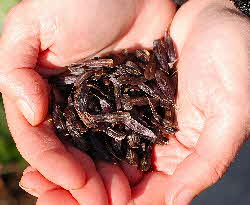Woad Facts
Yield of Woad dye
On a commercial scale, one acre of land produces about ten tonnes of leaves twice a year. One tonne of leaves produces just two kilos of woad powder.
Soap Making with woad
 60 kg of de-winged seeds produces 1 litre of woad oil for soap making. 60 kg of de-winged seeds produces 1 litre of woad oil for soap making.
Indigo
The indigotin produced by woad is identical to that produced by indigo plants. Read more on the Woad Chemistry page.
Cancer and woad
Woad has become another weapon in the fight against breast cancer. New research has found that this plant has 20 times more of the anti-cancer chemical glucobrassicin than broccoli. It is difficult to extract the chemical from broccoli, so woad can provide an effective alternative. Woad can produce even more of this chemical if the young leaves are damaged.
Magic using woad
Woad is also supposed to aid in shape-shifting and the study of past lives during magic rituals.
Woad as a Pest
Woad is considered to be a pest in some states of the USA. It should not be intentionally cultivated in 11 states but is legal to grow in the remaining 39 states (see USDA Plants Database in Links). It likes to grow in open cleared land and is not edible to livestock.
Woad in Chinese Medicine
Woad root granules are used in Chinese medicine for treatment of cold and throat infections.
Top of Page
|